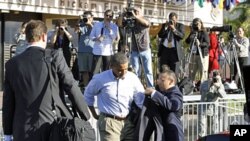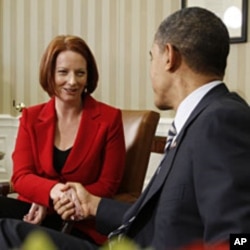President Barack Obama is continuing his Asia-Pacific trip by heading to Australia for a one day state visit with one of America's five security treaty allies in the region. Although brief, Mr. Obama's visit is expected to reaffirm strong historical, political and security ties between the United States and Australia.
Mr. Obama arrives in Australia after twice postponing his visit last year due to political and other domestic issues he faced at home.
He and Prime Minister Julia Gillard have forged what White Houses officials call an extremely warm relationship, and they have two "firsts" in common. She is the first woman to head an Australian government. Mr. Obama is the first African American president of the United States.
When Ms. Gillard visited the White House in March, she tossed an Australian football with Mr. Obama in the Oval Office, and visited a local school. While in Canberra, Mr. Obama is expected to visit schoolchildren after he addresses Australia's Parliament.
In a news briefing in Hawaii before Mr. Obama left for Canberra, White House Deputy Press Secretary Josh Earnest said the visit is intended to stress America's strong economic and security relationship with Australia.
"There are important economic implications in terms of the relationship that we have and the commerce that is facilitated between our two countries,"saiad Earnest. "But he will also talk about the important strategic relationship in terms of the security cooperation that we have between the United States and Australia."
The visit will also mark the 60th anniversary of the ANZUS security treaty, signed in 1951, which also includes New Zealand. Mr. Obama will lay wreathes at two Australian war memorials.
On Thursday, in the northern city of Darwin, scene of a major Japanese bombing raid during World War Two, the president will visit a Royal Australian Air Force base and address Australian troops and U.S. Marines.
In remarks to reporters in Hawaii, U.S. Pacific Commander Admiral Robert Willard called Australia a strong ally that is found alongside U.S. forces wherever they operate in the world.
"We have a very, very tight, close relationship with our Australian friends; we train in Australia on a fairly routine basis," said Admiral Willard. "There is a large scale combined armed exercise that we conduct annually. And the Australians are a very generous military insofar as access to their bases and to their training facilities."
In the background are regional security issues, including increased assertiveness by China, including in the South China Sea far north of Australia, where East Asian nations have rival claims.
U.S. officials declined to discuss details of an expected U.S.-Australia agreement ahead of President Obama's visit. But Australian media reports say it will involve increased U.S. access to ports and training facilities, and prepositioning of equipment.
Asked whether the agreement would serve as a "counterweight" in the region to China, Admiral Willard said it would contribute to relieving some of the pressure of maintaining an effective and sustained forward-deployed U.S. presence in the Asia-Pacific region.
China has also grown to be Australia's leading trading partner - the United States is third after Japan. China has sharply increased iron ore and uranium imports from Australia.
Australia is part of President Obama's overall focus on doubling exports and competing more aggressively in the Asia-Pacific region to help create jobs in the United States.
Australia is one of nine countries in a new Trans-Pacific Partnership the United States is promoting as a model for trade, which China has criticized as protectionist and contrary to the spirit of the World Trade Organization.













